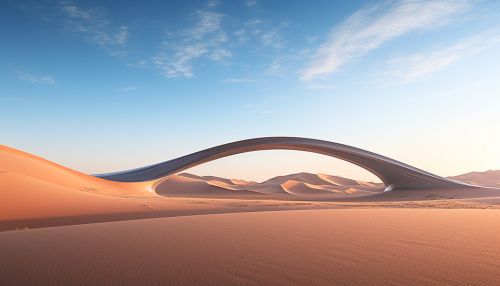Parabolic dune
Introduction
A parabolic dune is a type of sand dune that is U-shaped and open towards the upwind direction. These dunes are formed in areas where there is a strong unidirectional wind and ample supply of sand. The formation of parabolic dunes requires vegetation to stabilize the sand and allow the dune to maintain its shape.


Formation
Parabolic dunes are formed from barchan or transverse dunes that have vegetation growing on them. The vegetation slows down the movement of the dune and causes the arms of the dune to grow longer than the middle, creating a U-shape. The dune continues to move downwind, but the vegetation holds the arms in place, causing the dune to become parabolic in shape.
Characteristics
Parabolic dunes are characterized by their U-shape, with the open end of the U facing upwind. The arms of the dune, also known as the trailing ridges, are stabilized by vegetation and can extend for several kilometers. The central part of the dune, known as the nose, is devoid of vegetation and moves in the direction of the wind.
Types of Parabolic Dunes
There are two main types of parabolic dunes: coastal parabolic dunes and inland parabolic dunes.
Coastal Parabolic Dunes
Coastal parabolic dunes are found along seashores and are formed by the action of sea winds. These dunes are stabilized by coastal vegetation and can extend inland for several kilometers.
Inland Parabolic Dunes
Inland parabolic dunes are found in arid and semi-arid regions and are formed by the action of desert winds. These dunes are stabilized by desert vegetation and can extend for several kilometers.
Distribution
Parabolic dunes are found in various parts of the world, including the coastal areas of Australia, New Zealand, and the United States, as well as the desert regions of Africa and the Middle East.
Ecological Importance
Parabolic dunes play an important role in the ecology of the areas where they are found. The vegetation that stabilizes the dunes provides a habitat for various species of plants and animals. In coastal areas, parabolic dunes also provide a natural barrier against sea level rise and storm surges.
Human Interaction
Human activities can have a significant impact on parabolic dunes. Overgrazing, deforestation, and other forms of land degradation can destabilize the dunes and lead to their movement, which can cause damage to infrastructure and agricultural land. On the other hand, the stabilization of parabolic dunes through the planting of vegetation can be used as a form of land reclamation in desert areas.
